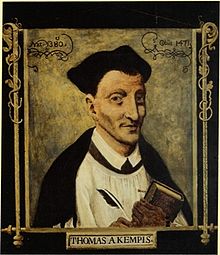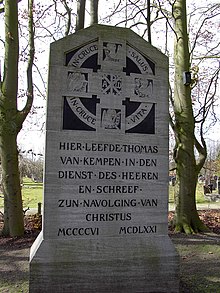Thomas à Kempis
The Reverend Thomas à Kempis | |
|---|---|
 | |
| Born | 1380 Kempen, Prince-Archbishopric of Cologne, Holy Roman Empire |
| Died | 25 July 1471 (aged 90–91) Zwolle, Bishopric of Utrecht, Holy Roman Empire |
| Venerated in | Anglicanism Lutheranism |
| Major shrine | Onze-Lieve-Vrouw-ten-Hemelopnemingkerk |
| Feast | 30 August |
| Influences | Plato, Aristotle, Socrates, Saint Augustine, Saint Thomas Aquinas, Joan of Arc, Dante Alighieri, Paul the Apostle, Geert Groote, Florens Radewyns, Henry Suso |
| Influenced | Alexander Hegius von Heek, Thérèse of Lisieux, Thomas More, John Fisher, Ignatius of Loyola, Erasmus, Edmund Burke, Joseph De Maistre, Thomas Merton, John Wesley, José Rizal, Swami Vivekananda, Shailer Mathews, Søren Kierkegaard |
| Major works | The Imitation of Christ |




Thomas à Kempis, CRV (c. 1380 – 25 July 1471;[2] German: Thomas von Kempen; Dutch: Thomas van Kempen[3]) was a German-Dutch Catholic canon regular of the late medieval period and the author of The Imitation of Christ, published anonymously in Latin in the Netherlands c. 1418–1427, one of the most popular and best known Christian devotional books. His name means "Thomas of Kempen", Kempen being his home town.
He was a member of the Modern Devotion, a spiritual movement during the late medieval period, and a follower of Geert Groote and Florens Radewyns, the founders of the Brethren of the Common Life.[4]
Life
[edit]Thomas was born in Kempen in the Rhineland.[5] His surname at birth was Hemerken (or Hammerlein), meaning the family's profession, "little hammer", Latinized into "Malleolus".[6] His father, Johann, was a blacksmith and his mother, Gertrud, was a schoolmistress.[5] In his writings he signed himself "Thomas Kempensis" or "Thomas Kempis".[7]
In 1392, Thomas followed his brother, Johann, to Deventer in the Netherlands in order to attend the noted Latin school there. While attending this school, Thomas encountered the Brethren of the Common Life, followers of Gerard Groote's Modern Devotion. He attended school in Deventer from 1392 to 1399.[5]
After leaving school, Thomas went to the nearby city of Zwolle to visit his brother again, after Johann had become the prior of the Monastery of Mount St. Agnes there. This community was one of the Canons Regular of the Congregation of Windesheim, founded by disciples of Groote in order to provide a way of life more in keeping with the norms of monastic life of the period. Thomas himself entered Mount St. Agnes in 1406. He was not ordained a priest, however, until almost a decade later. He became a prolific copyist and writer. Thomas received Holy Orders in 1413[8] and was made sub-prior of the monastery in 1429.[9]
His first tenure of office as subprior was interrupted by the exile of the community from Agnetenberg in 1429. A dispute had arisen in connection with an appointment to the vacant See of Utrecht. Pope Martin V rejected the nomination of Bishop-elect Rudolf van Diepholt, and imposed an interdict. The Canons remained in exile in observance of the interdict until the question was settled in 1432. During this time, Thomas was sent to Arnhem to care for his ailing brother, where he remained until his brother died in November 1432.[8]
Otherwise, Thomas spent his time between devotional exercises in writing and in copying manuscripts. He copied the Bible no fewer than four times,[8] one of the copies being preserved at Darmstadt, Germany, in five volumes. In its teachings he was widely read and his works abound with biblical quotations, especially from the New Testament.
As subprior he was charged with instructing novices, and in that capacity wrote four booklets between 1418 and 1427, later collected and named after the title of the first chapter of the first booklet: The Imitation of Christ. Thomas More said it was one of the three books everybody ought to own.[10] Thirteen translations of The Imitation of Christ and three paraphrases in English seem to have been published between 1500 and 1700.[11] Thomas died near Zwolle in 1471. There is a legend that he was denied canonization some 200 years after his death by the Catholic Church due to the presence of scratch marks on the interior of his coffin lid, which supposedly disqualifies him from sainthood as it would mean he did not peacefully embrace death.[12][self-published source?] However, there is scant evidence to support that he was buried alive or the idea that the Church would have denied him sainthood if they did discover he died in this manner.[citation needed]
Works
[edit]
Kempis's 1441 autograph manuscript of The Imitation of Christ is available in the Bibliothèque Royale in Brussels (shelfmark: MS 5455-61).[13]
He also wrote the biographies of New Devotion members—Gerard Groote, Floris Radewijns, Jan van de Gronde, and Jan Brinckerinck.[13] His important works include a series of sermons to the novices of St. Augustine Monastery, including Prayers and Meditations on the Life of Christ, Meditations on the Incarnation of Christ, Of True Compunction of Heart, Soliloquy of the Soul, Garden of Roses, Valley of Lilies, and a Life[14] of St. Lidwina of Schiedam.
- Thomas à Kempis (2007), The Imitation of Christ, Filiquarian, ISBN 978-1-59986-979-7
- Thomas à Kempis (2005), The Imitation of Christ: A Spiritual Commentary and Reader's Guide, Ave Maria Press, ISBN 0-87061-234-4
- Thomas à Kempis (1989), William C. Creasy (ed.), The Imitation of Christ, Mercer University Press, ISBN 0-86554-339-9
- Thomas à Kempis (1955), Harold C. Gardner, S.J. (ed.), The Imitation of Christ, Doubleday, ISBN 978-0-375-70018-7
Quotations
[edit]The following quotes are attributed to him:
And when he is out of sight, quickly also is he out of mind.
— The Imitation of Christ, Book I, ch. 23
Without the Way, there is no going,
Without the Truth, there is no knowing,
Without the Life, there is no living.
If thou wilt receive profit, read with humility, simplicity, and faith, and seek not at any time the fame of being learned.
At the Day of Judgement we shall not be asked what we have read, but what we have done.
— The Imitation of Christ, Book I, ch. 3
For man proposes, but God disposes
— The Imitation of Christ, Book I, ch. 19
If, however, you seek Jesus in all things, you will surely find Him.
— The Imitation of Christ, Book II, ch. 7
O quam cito transit gloria mundi,
Oh how quickly the glory of the world passes away!
— The Imitation of Christ, Book I, ch. 3, line 6.
Suggested as the origin of the phrase "Sic transit gloria mundi,"
"Thus passes the glory of the world."[15]
In angello cum libello [with slight variations]
In a little corner with a little book
— Shortened form of a motto often ascribed to, or associated with, Thomas a Kempis. The complete saying as reported by an early biographer is a mixture of Latin and Dutch and runs as follows: "In omnibus requiem quaesivi, sed non inveni, nisi in hoexkens ende boexkens," "I have sought everywhere for peace, but I have found it not, save in nooks and in books."[16][a]
Veneration
[edit]A monument was dedicated to his memory in the presence of the archbishop of Utrecht in St. Michael's Church, Zwolle, on 11 November 1897. In 1964, this church closed, causing his shrine to be moved to a new St. Michael's Church outside the centre of Zwolle. In 2005, this church also closed and his shrine was moved to the Onze-Lieve-Vrouw-ten-Hemelopneming kerk (Assumption of Mary church) in the centre of Zwolle.[17]
Notes
[edit]- ^ Franciscus Tolensis, Vita Thomae a Kempis, 12: "Ostenditur adhuc ejus effigies, sed admodum deformata poenèque obliterata, cum hoc insigni symbolo, In omnibus requiem quaesivi, sed non inveni, nisi in hoexkens ende boexkens: Hoc est, in abditis recessibus & libellulis." (Eusebius Amort 1759, p. 29)
References
[edit]- ^ "Opera". lib.ugent.be. Retrieved 2020-08-26.
- ^ Bijdragen en Mededelingen betreffende de Geschiedenis der Nederlanden, 87, p. 137.
- ^ "Thomas à Kempis". Christian History | Learn the History of Christianity & the Church. 8 August 2008. Retrieved 2018-10-22.
- ^ Van Engen 2013, pp. 394–.
- ^ a b c Kempis (2004). On the Passion of Christ according to the four evangelists. Ignatius Press. pp. 9–12. ISBN 9780898709933.
- ^ Carraway, James L. (1962) [1957]. The Imitation of Christ (3rd ed.). Great Britain: William Collins Sons & Co. Ltd. p. V. ASIN B001XQECXQ.
He was the second son John and Gertrude Hamerken (or Hammerlein, 'Little Hammer'), latinised, as was the custom of the age, into 'Malleolus.'
- ^ John-Julian (2012). "Introduction - Thomas Hamerken". In John-Julian (ed.). The Complete Imitation of Christ. Brewster, MA: Paraclete Press. ISBN 978-1557258106.
- ^ a b c Scully 1912.
- ^ "Thomas a Kempis, Priest, Monk, and Writer". Christianity.com. Retrieved 2018-10-22.
- ^ ""Thomas à Kempis", Christian History, August 8, 2008".
- ^ Crane 1975, pp. 79–100.
- ^ Moore, Timothy (27 July 2016). "Why Isn't Thomas a'Kempis a Saint of the Catholic Church?". Imitating Christ In Daily Life. Retrieved 19 June 2022.
- ^ a b William C. Creasy (2007). "Introduction". The Imitation of Christ. Mercer University Press. pp. xix–xx.
- ^ Thomas, à Kempis 1912b.
- ^ "Oxford Reference". Retrieved 2022-03-12.
- ^ Wright & Sinclair 1931, pp. 361-.
- ^ "Welkom op de website van de 'Peperbus' te Zwolle". Archived from the original on 2013-09-27. Retrieved 2013-05-28.
Sources
[edit]- This article incorporates Public Domain material from the New Schaff-Herzog Encyclopedia of Religious Knowledge, Vol. VI: Innocents — Liudger, Schaff, Philip.
- Scully, Vincent Joseph Henry (1912). . In Herbermann, Charles (ed.). Catholic Encyclopedia. Vol. 14. New York: Robert Appleton Company.
- Thomas, à Kempis (1912b). Vincent Scully (ed.). St. Lydwine of Schiedam, virgin. London: Burns & Oates.
- Crane, David (1975). "English Translations of the Imitatio Christi in the Sixteenth and Seventeenth Centuries". Recusant History. 13 (2): 79–100. doi:10.1017/S0034193200032489. ISSN 0034-1932. S2CID 165043846.
- Eusebius Amort (1759). Scutum Kempense seu IV librorum de imitatione Christi vindiciae.
- Wright, Frederick Adam; Sinclair, Thomas Alan (1931). A History of Later Latin Literature from the Middle of the Fourth to the End of the Seventeenth Century. G. Routledge.
- Van Engen, John (2013). Sisters and Brothers of the Common Life: The Devotio Moderna and the World of the Later Middle Ages. University of Pennsylvania Press. ISBN 978-0-8122-9005-9.
Further reading
[edit]- Chisholm, Hugh, ed. (1911). . Encyclopædia Britannica. Vol. 26 (11th ed.). Cambridge University Press.
External links
[edit]- Works by Thomas à Kempis in eBook form at Standard Ebooks
- Works by Thomas à Kempis at Project Gutenberg
- Works by or about Thomas à Kempis at the Internet Archive
- Works by Thomas à Kempis at LibriVox (public domain audiobooks)

- Read Imitation of Christ online
- Quotes from Thomas à Kempis
- Devotio Moderna
- Thomas à Kempis College, Zwolle, Netherlands; at Wikipedia (NL)
- 1380 births
- 1471 deaths
- 15th-century biographers
- 15th-century Christian mystics
- 15th-century Dutch Roman Catholic priests
- 15th-century German Roman Catholic priests
- 15th-century writers in Latin
- Augustinian canons
- Burials in Overijssel
- Christian hagiographers
- Devotio Moderna
- Dutch biographers
- Dutch male writers
- German biographers
- German expatriates in the Netherlands
- German male biographers
- German Roman Catholic writers
- Medieval Christian devotional writers
- Medieval European scribes
- German scribes
- People from the Electorate of Cologne
- People from Zwolle
- Pre-Reformation Anglican saints
- Roman Catholic mystics
